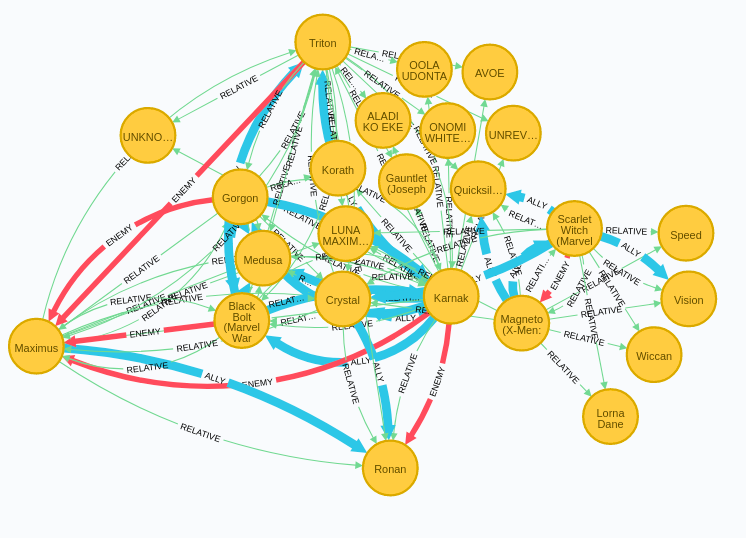Hi everyone,
I hope your week is going well. After receiving a lot of feedback about the lack of usage examples in the APOC documentation, Jennifer Reif and I have been busy adding those examples!
So far we’ve written examples for 340 functions and procedures, so we’re just over halfway there. Let us know if we can improve these examples using the feedback form that’s on every page.
This week’s video is Jan Zak’s NODES 2020 presentation where he shows how to create a graph visualization using PIXI.js.
This was a big week for software releases, with Neo4j 4.2 and Hume 2.6.0 being launched into the world.
We have a couple of great blog posts about the Graph Data Science Library and Hantsy shows how to create an audit trail using Spring Data Neo4j.
Cheers, Mark and the Developer Relations team
Featured Community Member: Julia Neagu
This week’s featured community member is Julia Neagu.

Julia Neagu – This Week’s Featured Community Member
Julia is the Director of Analytics at Tamr, where she is expanding the company’s analytics and data science solutions. Tamr is a startup that uses machine learning to solve the data curation problem.
Before joining Tamr, Julia led the development of data science products at Aon’s Intellectual Property Solutions group. She also has a Ph.D. in Physics from Harvard.
Julia recently presented Neo4j with Cloud-Native Data Mastering for the Enterprise at the Neo4j Connections: Graph Architecture and Integrations event.
After giving a high-level overview of Neo4j and Tamr, Julia and Nav Mathur demonstrate how to build an anti-money laundering solution using Tamr and Neo4j. Tamr handles the import of data and subsequent entity disambiguation before Neo4j is used to apply graph analysis.
Building a Graph Visualization with PIXI.js
Our video this week is Jaz Zak’s Building a Graph Visualization with PIXI.js, from the NODES 2020 virtual conference.
In the talk, Jan shows how to do basic visualization tasks using WebGL and Canvas. He then shows how we can simplify our lives by using a higher-level library like PIXI.js. After explaining its basic features, Jan gives a quick demo of a graph visualization created using PIXI.js.
How to get started with the Graph Data Science Library of Neo4j

Clair Sullivan has written an extensive introduction to the Graph Data Science Library.
Clair shows how to import a Game of Thrones graph, before showing how to run the PageRank centrality and Louvain community detection algorithms over the graph.
Data Auditing with Spring Data Neo4j

Hantsy continues the series of blog posts showing how to use Neo4j with Spring Boot.
In the second post, Hantsy extends a Spring Data Neo4j project to have data auditing support, which results in all database changes being streamed to a log file.
Neo4j 4.2 released, Hume 2.6 released, Dump and Load in Neo4j Desktop

- Richard Macaskill announced the release of Neo4j 4.2. This version has an enhanced Cypher planner, improved OLTP optimisation runtime, as well as enhanced security features.
- Dr. Alessandro Negro announced the release of version 2.6.0 of Hume, the graph-powered insights engine. This version has a perspectives feature that makes knowledge graph management easier, improved graph visualisation, and simplified management of multiple projects.
- Daniel Heward-Mills shows how to connect to Neo4j using OpenLink Software’s ODBC-JDBC Bridge Drivers. This makes it possible to use Neo4j with ODBC-compliant applications such as Excel for Mac, Virtuoso Universal Server, and FileMaker Pro.
- Tomaz Bratanic walks us through how to dump and load a database using Neo4j Desktop.
- Alberto De Lazzari builds a Hopfield neural network model in Neo4j and then uses it to predict images of people in the Neo4j community.
Introducing the new k-nearest neighbors algorithm in the Graph Data Science library

In Tomaz Bratanic’s latest blog post, he explores the k-Nearest neighbours algorithm that was recently added to the Graph Data Science Library.
After employing his web scraping skills to build a Marvel Universe graph, Tomaz does some exploratory analysis to find the most popular characters and groups.
He then explores communities of allies and relatives, writing a custom algorithm based on the weakly connected components algorithm to find communities that don’t contain any enemies.
And finally, Tomaz creates a characters similarity graph based on their stats and runs community detection algorithms on top of that graph as well.
Tweet of the Week
My favourite tweet this week was by Nigel Small:
#Py2neo 2020.1.0 has just been released, including:
— Nigel Small ?? (@technige) November 16, 2020
– Support for Neo4j 4.1
– Experimental routing and readonly txns
– Removed old node/rel caches
– Removed Graph/GraphService instance reuse
– Should now work with multiprocessinghttps://t.co/CLu62VSub4#Python #Neo4j
Don’t forget to RT if you liked it too!



